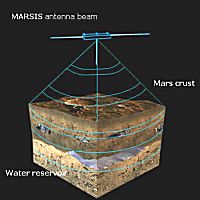 August 31: Europeans will seek water on Mars. Clues like patterned cracks on the surface suggest that Mars was once wet. Underground water may still be present. "The European Space Agency's Mars Express followed by the Netlanders, led by the French space agency, CNES, will be the first missions capable of prospecting directly for underground water on Mars." Mars Express will carry a ground penetrating radar, called MARSIS, into polar orbit around Mars in 2003. It willl work much like airborne radar that prospects for underground minerals on Earth. The Italian space agency, ASI, is proposing to fly SHARAD on NASA's 2005 orbiter to look for water in the top few hundred metres of crust. And In 2007, Europe will send four small Netlanders to different locations on Mars from where they will sound the Martian interior seismically.
August 31: Europeans will seek water on Mars. Clues like patterned cracks on the surface suggest that Mars was once wet. Underground water may still be present. "The European Space Agency's Mars Express followed by the Netlanders, led by the French space agency, CNES, will be the first missions capable of prospecting directly for underground water on Mars." Mars Express will carry a ground penetrating radar, called MARSIS, into polar orbit around Mars in 2003. It willl work much like airborne radar that prospects for underground minerals on Earth. The Italian space agency, ASI, is proposing to fly SHARAD on NASA's 2005 orbiter to look for water in the top few hundred metres of crust. And In 2007, Europe will send four small Netlanders to different locations on Mars from where they will sound the Martian interior seismically.
 Europe to identify underground water on Mars, ESA, 27 Aug 2001.
Europe to identify underground water on Mars, ESA, 27 Aug 2001.
 ESA Takes The Lead In Prospecting For Water On Mars, UniSci, 31 Aug 2001.
ESA Takes The Lead In Prospecting For Water On Mars, UniSci, 31 Aug 2001.
 Life on Mars! is the related CA webpage.
Life on Mars! is the related CA webpage.
August 31:
Tagish Lake meteorite may be a D asteroid because it is darker and redder than other carbonaceous chondrites. If so, it is the first example ever recovered.
 Rare Canadian Meteorite Tagged as First of Its Kind Found on Earth, by Robin Lloyd, Astrobiology Magazine, 2 Jun 2002.
Rare Canadian Meteorite Tagged as First of Its Kind Found on Earth, by Robin Lloyd, Astrobiology Magazine, 2 Jun 2002.
 Comets... is a related CA webpage.
Comets... is a related CA webpage.
August 27:
Jack Farmer before House Subcommiteee on Space and Aeronautics. [Thanks, Marsbugs.]
 Advances in our Understanding of Life: Excerpts from the testimony of Jack D. Farmer, SpaceDaily.com, 21 August 2001.
Advances in our Understanding of Life: Excerpts from the testimony of Jack D. Farmer, SpaceDaily.com, 21 August 2001.
 Testimony of Jack D. Farmer: full transcript, SpaceRef.com, 12 July 2001.
Testimony of Jack D. Farmer: full transcript, SpaceRef.com, 12 July 2001.
August 22:
Bioastronomy 2002 Conference, Great Barrier Reef, 8-12 July 2002. [Thanks, CC-Net.]
 Bioastronomy 2002: Life Among the Stars, conference homepage.
Bioastronomy 2002: Life Among the Stars, conference homepage.
 August 20:
August 20:
Sir Fred Hoyle died today. He was 86 years old. He was born in Bingley, Yorkshire, England on June 24, 1915. He received a master's degree from Cambridge in 1939 and was elected Fellow, St. John's College, Cambridge in the same year. In 1958 he rose to become Plumian Professor of Astrophysics and Natural Philosophy. He was a leading contributor in the discovery of how the elements from lithium to iron are synthesized inside stars. In 1997 he was awarded the Crafoord Prize by the the Swedish Academy in recognition of outstanding basic research in fields not covered by the Nobel prize. He leaves his wife Barbara, a son and a daughter, and four granddaughters.
 Fred Hoyle Dies at 86; Opposed 'Big Bang' but Named It, The New York Times, 22 August 2001.
Fred Hoyle Dies at 86; Opposed 'Big Bang' but Named It, The New York Times, 22 August 2001.
 Fred Hoyle, astronomer, cosmologist and author (1915 - 2001), ESA, 23 August 2001.
Fred Hoyle, astronomer, cosmologist and author (1915 - 2001), ESA, 23 August 2001.
 Professor Sir Fred Hoyle, The Daily Telegraph, 22 August 2001.
Professor Sir Fred Hoyle, The Daily Telegraph, 22 August 2001.
 Big bang' astronomer dies, BBCNews, 22 August 2001.
Big bang' astronomer dies, BBCNews, 22 August 2001.
 Professor Sir Fred Hoyle, The Times, 22 August 2001.
Professor Sir Fred Hoyle, The Times, 22 August 2001.
 Professor Sir Fred Hoyle, by Chandra Wickramasinghe, The Independent, 23 August 2001.
Professor Sir Fred Hoyle, by Chandra Wickramasinghe, The Independent, 23 August 2001.
 Professor Sir Fred Hoyle, The Guardian, 23 August 2001.
Professor Sir Fred Hoyle, The Guardian, 23 August 2001.
 Big Enough to Bury Darwin, The Guardian, 23 August 2001.
Big Enough to Bury Darwin, The Guardian, 23 August 2001.
 Sir Fred Hoyle, Australian Broadcasting Corporation, 25 August 2001.
Sir Fred Hoyle, Australian Broadcasting Corporation, 25 August 2001.
 John Maddox, "Obituary: Fred Hoyle (1915-2001)" [html], v 413 p 270 Nature, 20 September 2001. "The hope must be that civility will break out among Hoyle's enemies now that he is dead."
John Maddox, "Obituary: Fred Hoyle (1915-2001)" [html], v 413 p 270 Nature, 20 September 2001. "The hope must be that civility will break out among Hoyle's enemies now that he is dead."
 An Interview With Fred Hoyle is a related CA webpage.
An Interview With Fred Hoyle is a related CA webpage.
 Thanks, Chandra Wickramasinghe and CC-Net.
Thanks, Chandra Wickramasinghe and CC-Net.
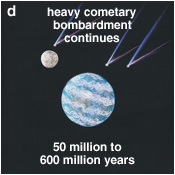 August 13:
August 13:
Pseudo-panspermia is becoming mainstream. In American Scientist, "Comet scientist Armand Delsemme reviews the evidence and argues that comets from the vicinity of Jupiter contributed the bulk of the constituents found in Earth's biosphere." Among these, he continues, are organic molecules that enabled life to start. "Pseudo-panspermia," the import of the "ingredients" of life from space, is not the full panspermia theory in which whole cells come from space. But the growing acceptance of this weakest version brings science closer to the theory we advocate. [Thanks, Loys Nunez.]
 Armand Delsemme, "An Argument for the Cometary Origin of the Biosphere," v 89 n 5, American Scientist, September-October 2001.
Armand Delsemme, "An Argument for the Cometary Origin of the Biosphere," v 89 n 5, American Scientist, September-October 2001.
 Introduction: More Than Panspermia is a related CA webpage.
Introduction: More Than Panspermia is a related CA webpage.
 Panspermia Asks New Questions, a related CA webpage, lists and explains the different versions of panspermia.
Panspermia Asks New Questions, a related CA webpage, lists and explains the different versions of panspermia.
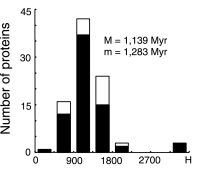 August 12:
August 12:
Fungi much older than their oldest fossils? Another molecular analysis finds genes or proteins that appear roughly twice as old as they should according to the fossil record. The analysts, biologists and astrobiologists at Penn State, are inclined to disbelieve the fossil record. "The first fossil land plants and fungi appeared 480 to 460 million years ago (Ma), whereas molecular clock estimates suggest an earlier colonization of land, about 600 Ma. Our protein sequence analyses indicate that green algae and major lineages of fungi were present 1000 Ma and that land plants appeared by 700 Ma." Similar discrepancies have already been observed for several other species, and some scientsts say that the molecular clocks are not reliable. Could the anomaly indicate that genes really are older than their first expression on Earth?
 Daniel S. Heckman et al., "Molecular Evidence for the Early Colonization of Land by Fungi and Plants," p 1027-1028 v 293, Science, 10 August 2001.
Daniel S. Heckman et al., "Molecular Evidence for the Early Colonization of Land by Fungi and Plants," p 1027-1028 v 293, Science, 10 August 2001.
 Land Plants' History Rewritten, by Elizabeth Pennisi, ScienceNOW, 9 August 2001.
Land Plants' History Rewritten, by Elizabeth Pennisi, ScienceNOW, 9 August 2001.
 Metazoan Genes Older Than Metazoa? is a related CA webpage.
Metazoan Genes Older Than Metazoa? is a related CA webpage.
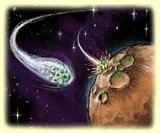 August 2:
August 2:
Web article about panspermia. [Thanks, Jim McGee.]
 Panspermia: Where Did We Come From?, by Emily Willingham, (originally) hmsbeagle.com, 20 July 2001.
Panspermia: Where Did We Come From?, by Emily Willingham, (originally) hmsbeagle.com, 20 July 2001.
 Introduction: More Than Panspermia is a related CA webpage.
Introduction: More Than Panspermia is a related CA webpage.
July 31:
The Astrobiology Conference in San Diego, sponsored by SPIE, included sessions on Mars meteorite ALH84001, water on Mars, the Viking life detection experiments and many other astrobiology-related topics. Some of the highlights of the July 30-31 meeting:
- David S. McKay of NASA's Johnson Space Center, well aware that meteorites can become contaminated on Earth, still sees plenty of good evidence that the biological fossils in several Mars meteorites are not contaminants. The fossils are often wrapped in clay or embedded in the matrix in ways that recent contaminants wouldn't be. And a nonbiological source for the single-crystal magnetites in ALH84001 has not been discovered.

- Principal conference organizer Richard Hoover points out that some of the organics in carbonaceous meteorites are biological degradation products that could not have formed in the short time since the meteorites fell. Furthermore, some of the fosslized microbes in them are photosynthesizers that would not colonize the dark interior of a meteorite, as Earthly contaminants would have to do.
- Gil Levin, designer of the 1976-77 Mars Viking Mission's LR experiment, now promotes an upgraded version of the life-detection experiment using two nutrient broths of opposite chiralities. If the repsonses differ between them, not chemistry, but biology of one kind or another is implicated.
- M. Hecht of JPL, NASA said that ponds of liquid water could persist on Mars for a month or so under ice. He also explained that because the atmosphere is thinner on Mars, heat loss by radiation to the sky is more effective, and by convection to the air is less effective than on Earth. Therefore, on Mars, high on pole-facing slopes is just where you would expect to find melting groundwater.
- E.V. Pikuta proposed that sulfur- and sulfate- reducing bacteria might be found on Jupiter's moon Io!
- Several members of the NEAR team discussed stunning close-up images of EROS.
- "The detection of living cells in stratospheric samples" was the title of a paper given by Chandra Wickramasinghe. A balloon mission flown 21 January at altitudes up to 41 km over tropical India collected particles that absorbed lipophilic dyes used to detect living cells. Wickramasinghe said that the sterility of the apparatus, the height of the sampling, and the vertical distribution of the particles support the view that the cells are extraterrestrial. DNA and possibly isotope analyses remain to be done.
 Instruments, Methods, and Missions for Astrobiology IV: conference homepage with complete schedule of papers and authors.
Instruments, Methods, and Missions for Astrobiology IV: conference homepage with complete schedule of papers and authors.
 Scientists Say Mars Viking Mission Found Life, by Leonard David, originally: Space.com, 31 July 2001.
Scientists Say Mars Viking Mission Found Life, by Leonard David, originally: Space.com, 31 July 2001.
 USC neuroscientist finds signature of life on Mars in decades-old data, EurekAlert, 27 July 2001.
USC neuroscientist finds signature of life on Mars in decades-old data, EurekAlert, 27 July 2001.
 Do microbes rain down from space?: Reuters, London, 31 July 2001.
Do microbes rain down from space?: Reuters, London, 31 July 2001.
 Researcher: Mars rock varnish hints of life [Barry DiGregorio's work to be presented at San Diego], by Richard Stenger, CNN.com, 2 July 2001.
Researcher: Mars rock varnish hints of life [Barry DiGregorio's work to be presented at San Diego], by Richard Stenger, CNN.com, 2 July 2001.
 Life On Mars! is a related CA webpage.
Life On Mars! is a related CA webpage.
 Fossilized Life Forms in the Murchison Meteorite is a related CA webpage.
Fossilized Life Forms in the Murchison Meteorite is a related CA webpage.
 An Atmospheric Test... is a related CA webpage.
An Atmospheric Test... is a related CA webpage.
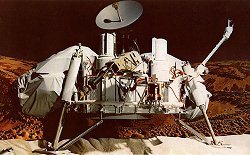 July 20:
July 20:
Twenty-fifth Anniversary of Viking's Landing on Mars.
 Happy Anniversary, Viking Lander, by Dr. Tony Phillips, Science@NASA, 20 July 2001.
Happy Anniversary, Viking Lander, by Dr. Tony Phillips, Science@NASA, 20 July 2001.
 Mars: Dead or Alive?, by Robert Evans, Astrobiology Magazine, 18 July 2001.
Mars: Dead or Alive?, by Robert Evans, Astrobiology Magazine, 18 July 2001.
 NASA Celebrates 25th Anniversary of Mars Landing, Newsrelease 01-143, NASA HQ, 17 July 2001.
NASA Celebrates 25th Anniversary of Mars Landing, Newsrelease 01-143, NASA HQ, 17 July 2001.
 Life On Mars! is the related CA webpage.
Life On Mars! is the related CA webpage.
 July 18:
July 18:
A NATO-sponsored Institute on Astrobiology will be held on Crete. Its objective is "to provide a systematic, in-depth, treatment of the new and rapidly developing field of Astrobiology by distinguished lecturers." The website lists Fred Hoyle and at least two Nobel laureates among the lecturers. [Thanks, Richard Hoover, Organizing Committee.]
 Perspectives in Astrobiology: NATO Advanced Studies Institute in Chania, Crete, 29 September to 10 October 2001: Proceedings [
Perspectives in Astrobiology: NATO Advanced Studies Institute in Chania, Crete, 29 September to 10 October 2001: Proceedings [
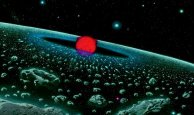 July 11: A dying star boils the comets around it. This is the best explanation for the huge amount of water vapor seen by the Submillimeter Wave Astronomy Satellite (SWAS) around CW Leonis, located 500 light years from Earth in the direction of the constellation Leo.
July 11: A dying star boils the comets around it. This is the best explanation for the huge amount of water vapor seen by the Submillimeter Wave Astronomy Satellite (SWAS) around CW Leonis, located 500 light years from Earth in the direction of the constellation Leo.
 Stellar Apocalypse Yields First Evidence of Water-bearing Worlds Beyond Our Solar System, SWAS, 11 July 2001.
Stellar Apocalypse Yields First Evidence of Water-bearing Worlds Beyond Our Solar System, SWAS, 11 July 2001.
 Sizzling Comets Circle a Dying Star, by Tony Phillips, Science@NASA, 11 July 2001.
Sizzling Comets Circle a Dying Star, by Tony Phillips, Science@NASA, 11 July 2001.
 Wet Solar System Found, by Richard A. Kerr, Science Now, 11 July 2001.
Wet Solar System Found, by Richard A. Kerr, Science Now, 11 July 2001.
 G. J.Melnick et al., "Discovery of water vapour around IRC+10216 as evidence for comets orbiting another star" [html], doi:10.1038/35084024, p 160-163 v 412, Nature, 12 July 2001.
G. J.Melnick et al., "Discovery of water vapour around IRC+10216 as evidence for comets orbiting another star" [html], doi:10.1038/35084024, p 160-163 v 412, Nature, 12 July 2001.
 Comets... is a related CA webpage.
Comets... is a related CA webpage.
July 11:
The moon, plate tectonics and life on Earth. "If the moon had not carried away most of the crust, there would be no ocean basins, no land, and no chance for life to evolve on land." [Thanks, Jim Galasyn.]
 The Moon And Plate Tectonics: Why We Are Alone, by Nick Hoffman, SpaceDaily, 11 July 2001.
The Moon And Plate Tectonics: Why We Are Alone, by Nick Hoffman, SpaceDaily, 11 July 2001.
 Gaia is a related CA webpage.
Gaia is a related CA webpage.
 July 9:
July 9:
NAI considers nanobes. Commonly known as nanobacteria, these particles are so small that most mainsream biologists think they cannot be alive. The smallest ones, at 20 nanometers in diameter, are about the size of a ribosome. But they can be lifelike in several respects, including growth or proliferation, physical form and DNA content. Fossilized ones were seen in the Mars meteorite, ALH84001, and were part of the case for former life on Mars. Their most visible champion is Robert Folk of the University of Texas, who has found them in Italian marble and almost anywhere else. One possibility not mentioned in the new web article is that at least some of the particles are the remains or distress products of normal (larger) bacteria.
 How Small Can Life Be? by Leslie Mullen, NASA's Astrobiology Institute +SpaceDaily, 23 July 2001.
How Small Can Life Be? by Leslie Mullen, NASA's Astrobiology Institute +SpaceDaily, 23 July 2001.
 Life On Mars! is a CA webpage with more about nanobes.
Life On Mars! is a CA webpage with more about nanobes.
July 6:
NAI comments on SETI in a review article on the web.
 The Meaning of Life by Lee Siegel, NASA's Astrobiology Institute, 6 July 2001.
The Meaning of Life by Lee Siegel, NASA's Astrobiology Institute, 6 July 2001.
 What Difference Does It Make? is a related CA webpage.
What Difference Does It Make? is a related CA webpage.
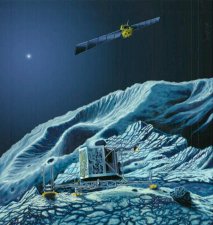 July 5:
July 5:
CONSERT ready for Rosetta. This 3kg package built in Germany and France will probe the internal structure of Comet Wirtanen's nucleus using an ingenious radar sounding technique. The Rosetta orbiter, at a range of 30 km, will send pulses through the comet to the lander where the signals will be detected and retransmitted to the orbiter. The time delay of the signal, in various directions, will give information about the comet's interior. [Thanks, Ron Baalke.]
 Rosetta's CONSERT heads for a real cool venue, ESA, 5 July 2001.
Rosetta's CONSERT heads for a real cool venue, ESA, 5 July 2001.
 Comet Rendezvous is a related section of the CA webpage Can The Theory Be Tested?.
Comet Rendezvous is a related section of the CA webpage Can The Theory Be Tested?.
